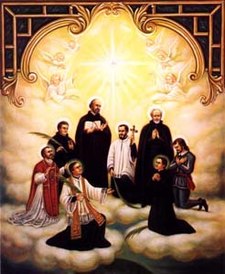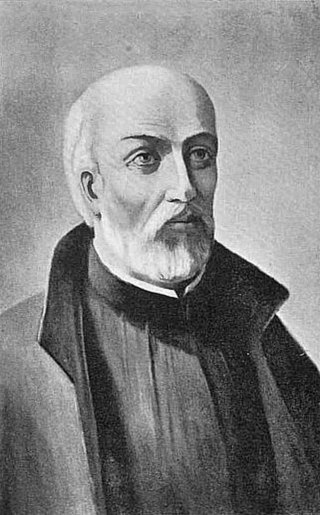
Jean de Brébeuf was a French Jesuit missionary who travelled to New France (Canada) in 1625. There he worked primarily with the Huron for the rest of his life, except for a few years in France from 1629 to 1633. He learned their language and culture, writing extensively about each to aid other missionaries.
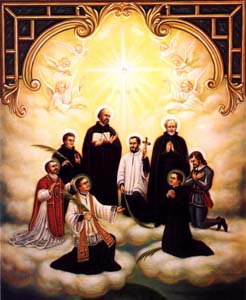
The Canadian Martyrs, also known as the North American Martyrs, were eight Jesuit missionaries from Sainte-Marie among the Hurons. They were ritually tortured and killed on various dates in the mid-17th century in Canada, in what is now southern Ontario, and in upstate New York, during the warfare between the Iroquioan tribes the Mohawk and the Huron. They have subsequently been canonized and venerated as martyrs by the Catholic Church.
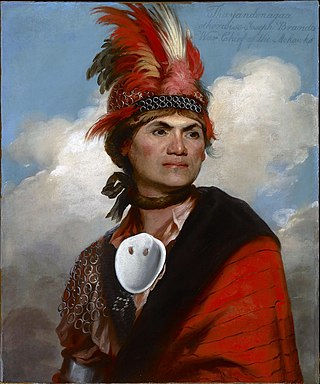
The Mohawk, also known by their own name, Kanien'kehà:ka, are an Indigenous people of North America and the easternmost nation of the Haudenosaunee, or Iroquois Confederacy.

Kateri Tekakwitha, given the name Tekakwitha, baptized as Catherine, and informally known as Lily of the Mohawks, is a Mohawk/Algonquin Catholic saint and virgin. Born in the Mohawk village of Ossernenon, in present-day New York, she contracted smallpox in an epidemic; her family died and her face was scarred. She converted to Catholicism at age 19. She took a vow of perpetual virginity, left her village, and moved for the remaining five years of her life to the Jesuit mission village of Kahnawake, just south of Montreal. She was beatified in 1980 by Pope John Paul II and canonized by Pope Benedict XVI at Saint Peter's Basilica on 21 October 2012.

Charles Garnier, was a Jesuit missionary working in New France. He was killed by Iroquois in a Petun village on December 7, 1649.
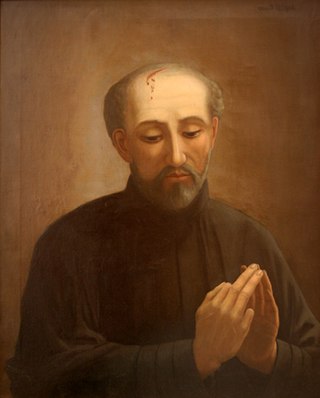
Isaac Jogues was a French missionary and martyr who traveled and worked among the Iroquois, Huron, and other Native populations in North America. He was the first European to name Lake George, calling it Lac du Saint Sacrement. In 1646, Jogues was martyred by the Mohawk at their village of Ossernenon, near the Mohawk River.

Sainte-Marie among the Hurons was a French Jesuit settlement in Huronia or Wendake, the land of the Wendat, near modern Midland, Ontario, from 1639 to 1649. It was the first European settlement in what is now the province of Ontario. Eight missionaries from Sainte-Marie were martyred, and were canonized by the Catholic Church in 1930. Sainte-Marie Among the Hurons was designated a National Historic Site of Canada in 1920. A reconstruction of the mission now operates as a living museum.

René Goupil,, was a French Jesuit lay missionary who became a lay brother of the Society of Jesus shortly before his death. He was the first of the eight North American Martyrs of the Roman Catholic Church to receive the crown of martyrdom and the first canonized Catholic martyr in North America.

Gabriel Lalemant was a French Jesuit missionary in New France beginning in 1646. Caught up in warfare between the Huron and nations of the Iroquois Confederacy, he was killed in St. Ignace by Mohawk warriors and is one of the eight Canadian Martyrs.

Jean-François Régis, SJ, commonly known as Saint John Francis Regis and Saint Regis, was a French priest of the Society of Jesus, recognized as a saint by the Catholic Church in 1737. A tireless preacher, Regis is best known for his work with at-risk women and orphans.

Auriesville is a hamlet in the northern part of New York state and west of Albany. It was the site of Ossernenon, a Mohawk village where French Jesuits established a mission. This operated from 1667 until 1684, when the Mohawk destroyed it as part of continuing confrontations with French colonists. Auries is said to have been the name of the last Mohawk known to have lived there. Later settlers named the village after him.
Father Simon Le Moyne, sometimes spelled Simon Le Moine, was a French Jesuit priest who became involved with the mission to the Hurons and Iroquois in the Americas. Le Moyne had acquired sixteen years of education and experience through priesthood in France before his arrival in New France in 1638. During that same year, he headed out to his mission in Huron country. The destruction of the Huron nation by the Iroquois brought him back east to what is modern day Quebec in 1650.
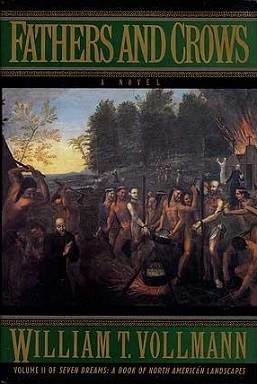
Fathers and Crows is a 1992 historical novel by the American author William T. Vollmann. It is the second book in the seven-book series Seven Dreams: A Book of North American Landscapes.

The National Shrine of the North American Martyrs, also known as the Shrine of Our Lady of Martyrs, is a Roman Catholic shrine in Auriesville, New York dedicated to the three Jesuit missionaries who were martyred at the Mohawk Indian village of Ossernenon in 1642 and 1646.
Between 1634 and 1655, the Jesuits established a home and a settlement in New France along the Saint Lawrence River. They soon moved deeper into the colony’s territory in order to live with and convert the local Huron population. During this time, however, their missionary efforts were fraught with disappointment and frustration. In other colonies, such as in Latin America, the Jesuit missions had found a more eager and receptive audience to Christianity, the result of a chaotic atmosphere of violence and conquest. But in New France, where French authority and coercive powers did not extend far and where French settlement was sparse, the Jesuits found conversion far more difficult. Nevertheless, the French missionary settlements were integral to maintaining political, economic, and military ties with the Huron and other native peoples in the region. The contact between the two had important consequences in lifestyle, social and cultural attitudes, as well as in spiritual practice. The French Jesuits and Huron found they had to negotiate their religious, social, and cultural differences in order to accommodate one another.

Camp Ondessonk is an outdoor, Catholic residential youth camp run by the Diocese of Belleville. It is located in the Shawnee National Forest of Southern Illinois, near Ozark, Illinois. The mission of the camp is "Exceptional outdoor and spiritual adventures empowering kids of all ages." Camp Ondessonk is accredited by the American Camp Association.
